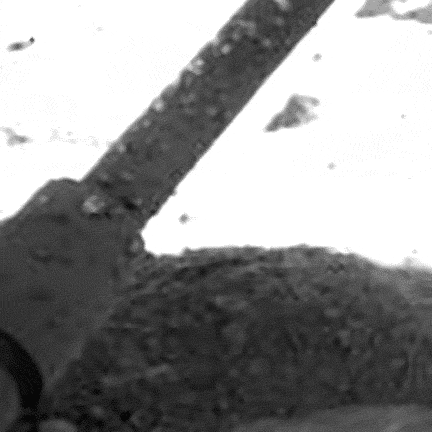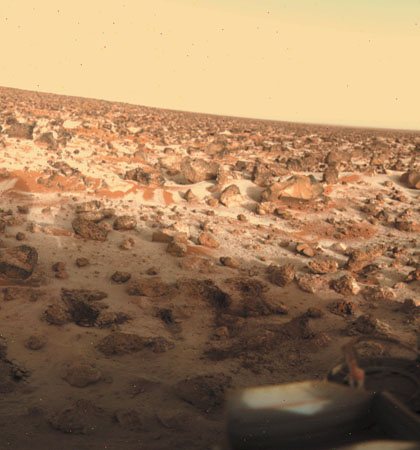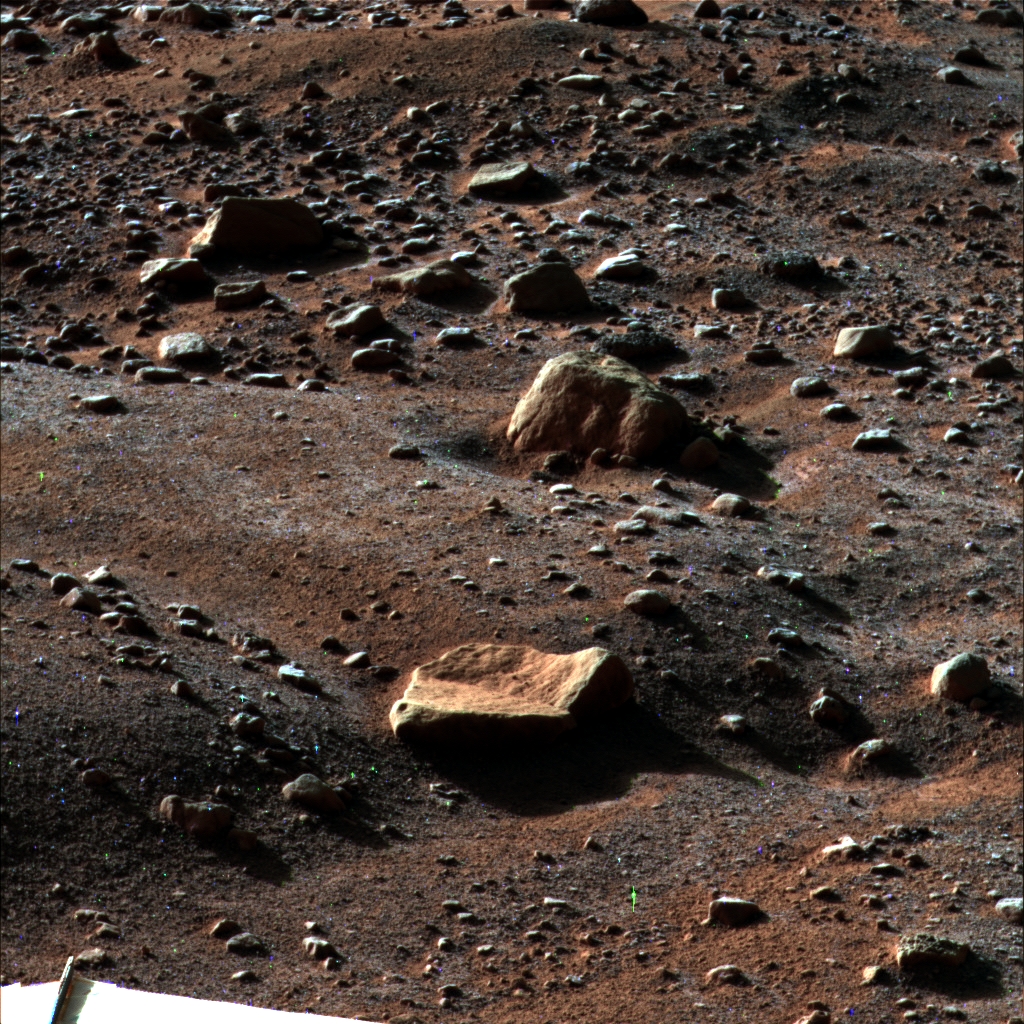[/caption]
It’s getting a little nippy at night on Mars. The Phoenix lander’s Surface Stereo Imager took this image at 6 a.m. on Sol 79 (August 14, 2008 here on Earth), and a thin layer of water frost is visible on the ground around the landing area. From subsequent images, the frost begins to disappear shortly after this image was taken as the sun rises on the Phoenix landing site.
The sun was about 22 degrees above the horizon when the image was taken, enhancing the detail of the polygons, troughs and rocks around the landing site.
This view is looking east southeast with the lander’s eastern solar panel visible in the bottom lefthand corner of the image. The rock in the foreground is informally named “Quadlings” and the rock near center is informally called “Winkies.”
This false color image has been enhanced to show color variations.
Earlier images taken in June, and put together here in sequence to form a movie, appears to show frost forming on Phoenix’s own legs.

But this isn’t the first time that frost has been imaged on Mars. The Viking lander took the picture below in 1979 of its landing site at Utopia Planetia showing ample amounts of frost on the surface.

In other news, the Phoenix lander also announced on Twitter that it has opened another TEGA oven door in preparation for receiving another sample of Martian soil to “bake and sniff.”
New Source: Phoenix Image Gallery, Wanderingspace.net


So there is moisture in the atmosphere… enough to condense?
“sol 79”
For crying out loud, why do you need a special name for a day on Mars? What are we going to call a day on the moon? A luna? What about a day on Mercury, or Neptune?
How about this: a day is the period from the rise of the sun over the local horizon to the next rise of the sun over the local horizon, regardless of how long that period is. A day is a day?
Frost on Mars. Bet it is nippy. “Won’t be riding the Harley today honey, I’m taking the car!”
Yet another interesting aspect of the Phoenix mission – a dynamic landscape. We can expect to see some ‘winter’ landscape shots in the coming months. For the first time a mars probe (on the ground) will be showing seasonal variations from Mars.
Shame the lander is unlikely to survive the winter.
This is a very nice image. I appreciate seeing the image of frost taken by Viking 2. I did not remember frost being detected then. But I was never able to see anything then except what made it to the newspapers or mgazines. There must be a wealth of info and pictures from Viking 2 and other earlier missions that never made it to where most of us could see it.
If anyone knows how to see a complete archive of Viking pictures via the internet, I would love to hear how to access it.
gregG Says: “We can expect to see some ‘winter’ landscape shots in the coming months.”
I know that there is no chance for rain between the frozen and gaseous states of H2O on Mars. But could it be possible to see sorts of “snowflakes”?
Good image, finally. This is the type of photo we appreciate, not dark thumbnails. You can really appreciate NASA immense work on such a far away planet only when they reciprocate with their public, admirers, press and taxpayers. There should be standards that permit viewers to receive clear pictures like this, in a letter size minimum format with smaller size options and HD whenever possible.
Kudos for the latest photos!
@ Charles Bell, 146 Viking 1 & 2 images (including frost pics) can be found at the NASA Photojournal site: http://photojournal.jpl.nasa.gov/mission/Viking?start=0. Both orbital & surface images can be found there (3 Martian frost images from Viking 2 are designated PIA00530, PIA00533 & PIA00573). For dollhopf, I believe the frost visible in this & other Viking images is carbon dioxide frost(CO2).
it’s ok..
That could be anything, but I I want to know if there is really water on Mars.
Well I guess its time to send a man to the moon already!
The polars of mars are frozen Ice caps. There are images of dried up riverbeds. There definately was at one time water on mars. You could argue that the caps are technically water haha.
For Charles Bell, 146 images from Viking 1 & 2 can be found at http://photojournal.jpl.nasa.gov/mission/Viking . Three surface images with frost are designated PIA00530, PIA00533 & PIA00573 and more are also at this site. I can remember seeing these for the first time (in Sky & Telescope, I believe) and thinking Mars really does have seasons like Earth. For dollhopf, I think the frost is from carbon dioxide (dry ice), not water, but still an amazing sight.
Does not it appear simple that frost means water in the atmosphere? What kind of temperature range exists between day and night to go below the dew point? Knowing this, and the atmospheric pressure on Mars, should not it be easy to calculate the amount of free atmospheric water available ?
This puzzles me?
If there is enough water to condense on the surface I dont see the problem of there being more underground. I read somewhere that the water could made into fuel. If that’s the case why have’nt we left already..
New Mexico is a beautiful place in the winter time, isn’t it?
I’m glad that they took care to not accidentally get the flower patch in the distance or the blue sky. Keeping the NASA tent out of the picture was flawless execution. Removing the gila monster without a trace shows how talented the boys and girls of NASA are with Photoshop.
All in all, TWO THUMBS UP!!
“This high-resolution color photo of the surface of Mars was taken by Viking Lander 2 at its Utopia Planitia landing site on May 18, 1979, and relayed to Earth by Orbiter 1 on June 7. It shows a thin coating of water ice on the rocks and soil. The time the frost appeared corresponds almost exactly with the buildup of frost one Martian year (23 Earth months) ago. Then it remained on the surface for about 100 days. Scientists believe dust particles in the atmosphere pick up bits of solid water. That combination is not heavy enough to settle to the ground. But carbon dioxide, which makes up 95 percent of the Martian atmosphere, freezes and adheres to the particles and they become heavy enough to sink. Warmed by the Sun, the surface evaporates the carbon dioxide and returns it to the atmosphere, leaving behind the water and dust. The ice seen in this picture, like that which formed one Martian year ago, is extremely thin, perhaps no more than one-thousandth of an inch thick.” This is the original caption for the Viking 2 frost image pictured above, from the site mentioned in my Aug 17 post above. It seems water & ice contribute to the frost seen on the surface. Subsurface water, though, seems to be the most abundant frozen compound below Phoenix. Hope this clears up some of the confusion.
Did you ever imagine just 6 months ago you’d see a matter-of-fact headline that states “Camera snaps frost on Mars?”
Incredible. The solar system has a lot more water than we give it credit for, with the recent discoveries of water on Mars, the Moon, and even Mercury of all places.
Then of course there’s the billions of comets with water and other volatiles.
Nancy Atkinson: “the frost begins to disappear shortly after this image was taken as the sun rises on the Phoenix landing site.”
inaminit Says: “How about this: a day is the period from the rise of the sun over the local horizon to the next rise of the sun over the local horizon, regardless of how long that period is. A day is a day?”
Quite unscientific semantics! The “Sun” does not “rise/set” above/below the horizon. Ever! I must be “nit picky” because it is the rotation of planet Earth or Mars or luna, etc., that causes the Sun “to appear to rise/set”. Buckminster Fuller recommended we “think” and “state’ it as “sunsight/ sunclipse”: You “see” the Sun as your own planetary horizon rotates it into view just as it does for our moon or other planets or stars, etc. Only those objects orbiting Earth below the Clarke Orbit actually rises/sets above/below the horizon.
Dear because you are too moronic to do this on your own go to http://www.dictionary.com and look up “sol”.
To save time, it is short for SOLAR DAY; which is used on the moon, venus, and inside your head, since sunlight manages to make it there.